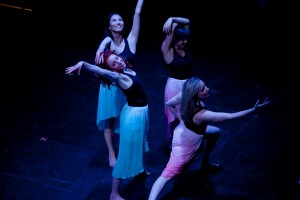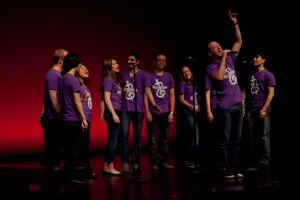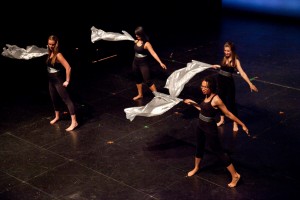by Kate | Aug 31, 2013
Walking down State Street this morning, undergrad overrun, I realized I’d better get in a few final thoughts about the summer months in Ann Arbor before we settle into fall.
One of the highlights of summer was having the flexibility to seek out more shadowing opportunities. Besides the obvious excitement that comes with seeing real cases, there is a more subtle delight in affirming that I genuinely love being with sick people and being in the hospital. At this stage in my training, I have no real (respons)abilities that contribute directly to patient care, yet I often come away feeling that both the patient and I benefitted from the interaction. I admit that I likely get the lion’s share of the joy, given that each time is new and exciting — I start to see some of the subtleties of what happens back in the call room, of who challenges whose authority, of how the system comes together. Then, of course, I get to actually see medicine applied, listen to real heart murmurs, and witness how patients respond to doctor’s advice.
Sometimes I simply observe, but other times I am involved in the visit, whether that means being part of the conversation in taking their health history or truly doing parts of the physical exam. While shadowing on the inpatient cardiology service, I got a sense of what it will be like to be an M3, from pre-rounding on your patient, to entering the vitals from overnight, to going on rounds and hearing each patient presented. A few weeks later, when I shadowed in the Psychiatric Emergency Room, I learned about some of the unique aspects of our separate psych evaluation area. Besides the patients themselves, I think what fascinated me most during this visit was learning about how it’s determined if and where to hospitalize psych patients. Finally, I went into the general outpatient medicine clinic in Taubman; it was here that I saw the greatest range of patients and complaints, from a young woman returning from India with gastrointestinal issues to an elderly man with concerns about recurrent headaches.
For the most part, patients seem to enjoy the presence of a student. I have yet to have a patient refuse to have me in the room and many of them actually appear relaxed and eager to talk to me. (Granted, it’s not as though I am requesting permission to do any procedure on them, but – in fact – the data indicates that patients are surprisingly willing to allow students to “practice” on them, under the careful supervision of an MD.) Getting things done in the hospital has a lot to do with the relationships, whether between a doctor and a patient, a nurse and an administrator or a student and a resident. Although I won’t begin clinical training for several more years, it’s motivating to start seeing more of what to expect.
by Kate | Aug 7, 2013
I’ll be honest, I genuinely love being back in a classroom where math is being done up on the chalkboard. I missed playing with numbers. For the last month or so, I’ve been taking intensive summer statistics workshops. Since eventually I will be doing biostats research through the School of Public Health, it made sense to dedicate part of this summer to some more formalized preparation. Earlier in the summer I did bits of calculus review on my own, but my current classes include matrix algebra and linear regression. I am a nerd, and I love that my desk looks like this right now.

One aspect of the classes that I appreciate most is the interdisciplinary nature of the students. In fact, most of them are political science students or others doing social science research. It is fun to learn about quantitative methods of analysis with people who deal with data sets that are often quite different than those we see in biomedical science. The nuances of their questions and of the problems they run into with their data are of a different sort. Perhaps more than anything, though, it’s been nice to walk through the statistical analysis and computer programming with others who are also learning it for the first time. Plus, the classes are over on Central Campus, so each day I have a beautiful walk down through the Diag!
by Kate | Jul 7, 2013
I suppose that technically we’re M2’s now, though it feels somewhat presumptuous to say that, since we haven’t yet started second-year coursework. It’s our last real summer! We have a few months “off” (though most people do research) between the first and second year of med school, then all the subsequent years are continuous.
The first week of summer I took as a true vacation. The day after my last final, I ran the Dexter-Ann Arbor half marathon with a group of med students…and we all finished! It was a gorgeous course along the river between the two towns and it was great fun to cross the finish line right in my own neighborhood. Since I hadn’t trained particularly intensely this spring, I decided in advance not to “race” but just to enjoy the day. Lucky for us, the run was the same day as the Ann Arbor food festival, so downtown streets were closed and overflowing with delicious samples. It was hot for June, and thirteen miles is a long run, but we were all still happy and talkative at the finish line together.
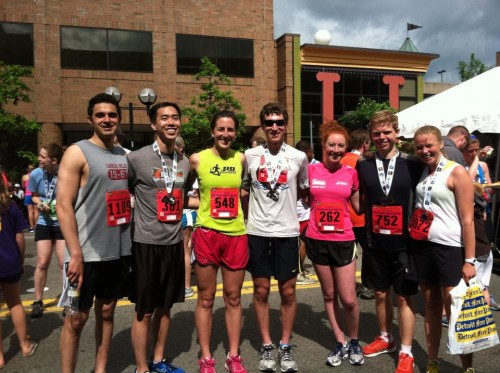
As an MD/PhD student, I spend this summer doing something relevant to the “PhD” part of the dual degree. For most of my cohort, that means doing lab rotations to identify potential mentors for their future research. For a few of us, though, who are not doing our degrees in a basic science field, it is more useful to take classes or do other types of non-bench research. Because I will be doing my PhD through the School of Public Health in biostatistics, I’m spending most of my summer getting up to speed on math. Through a combination of independent study, classes, and workshops, I’m using these months to start getting my feet wet in the numerical and quantitative side of things. Next fall, after finishing the second year of medical school, I will officially start at the School of Public Health, so it’s been exciting to begin feeling more connected to the work I’ll do there. In a couple weeks, I start a few more statistics and programming workshops though the Interuniversity Consortium for Political and Social Research, so stay tuned for updates on how those are! Until then, Happy Summer to all!
by Kate | Jun 3, 2013
Did we really just finish the first year? Apparently so.
The last few weeks of school were a wonderful blur of Embryology, Human Growth & Development, Clinical Foundations of Medicine…and barbeques. The two academic sequences (embryology and human growth) were fun in large part because they were so easy to relate to. Admittedly, there were certain parts of embryology that felt a bit detail-oriented, such as the precise migration of neurons, but even those facts are genuinely useful when you think about the pathology of specific birth defects. For every molecular detail of the regulation of growth, though, you also get to learn a fun embryology fact – the type that you can tell your little sister. Before a couple weeks ago, I never knew that an embryo is continuously swallowing its own amniotic fluid, or that the measurement of an expecting mother’s belly in centimeters estimates the gestational age in weeks (we call this “fundal height,” and it’s measured from the top of the uterus to the pubic bone). Then, the human growth course gives you a whirlwind tour of everything from the first breath of life until death, covering topics as diverse as identifying autism in toddlers to changing drug doses in the elderly.
Mixed in with these final weeks was another unit in our Clinical Foundations of Medicine curriculum. For the first time, we took complete health histories and did complete physical exams. Before seeing the standardized patients, we worked with our clinical educators and practiced on each other, but it was still a bit nerve-wracking to walk into the exam room and do everything from memory. The thing is, it eventually starts to come pretty naturally if you go through it enough times. Patients are people, and people are fun to talk to. Sure, I still sometimes forget to properly inspect the mouth or to ask about alcohol use, but if you make a different mistake each time then you learn from it. (Note: I also admit that there are things that I remember every time but that I know I have not yet mastered technique-wise. For instance, I do the fundoscopic exam on the eye, get the red reflex, see the vessels, and follow in to see the optic disk…but I’d have no idea if I saw anything weird in the vessels or disk. Same goes for the neck exam: I go through the motions but I am not convinced I have ever actually felt the thyroid gland. Finally, I never push deep enough when palpating the abdomen; I wouldn’t discover any sort of tumor or mass unless it was something like “baby.”)
We have a ways to go, but it’s fun to walk in there and think “I could do this one day. And it’s FUN.” Talking to patients, getting their stories, doing the physical exam, and coming up with a preliminary differential (however ridiculous and illogical) makes you realize you might have at least taken some baby steps in the right direction this year.
Just for fun, below is a picture of me in the opthamology lab session, when we were practicing the eye exam on each other. I had my right eye dilated using phenylephrine (so that it was easier to do the retinal exam using the opthalmoscope) and my left eye stained with fluorescein (to look for corneal abrasions using the slit lamp). Both eyes were numb the rest of the night, and with only one dilated I had a bit of trouble reading for a few hours.
That’s all for now! More soon on the joy that is summer in A2.
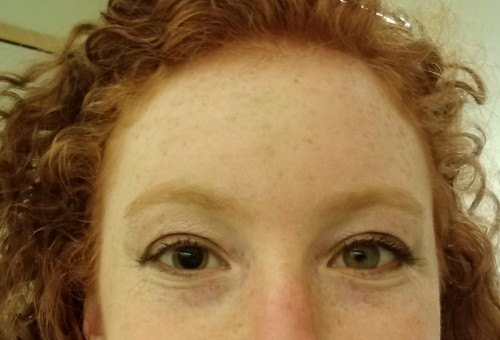
by Kate | May 24, 2013
Although not particularly harsh, winter was long this year; it was still snowing during the first week of May! In April, when we had our first real warm spell, I eagerly (read: foolishly) switched out all my storm windows and doors for their screen counterparts. Perhaps subconsciously I was determined that acting as though it were spring would make it so. More snow came after that, despite my plans, but now I think we have skipped right past spring and moved on to summer…it’s sunny, hot, and beautiful. The birds outside my window tend to wake me up around 5am, but I can’t even muster any annoyance because I’m so happy that my flowers are blooming and summer is near (or maybe here). I haven’t yet planted the tomatoes and basil, but our backyard flowers are in full bloom.

The change in weather corresponded with the end of an intense and fascinating med school sequence: infectious disease (ID). The pace of classes and labs changed with this sequence, partly because every morning we had required small groups. Many people who had previously been “streamers” (myself included) started going to class again. Since the lecture material from each morning was relevant to the small groups that were immediately following, it would have been difficult to keep up if you weren’t in class most days. After the first week of adjustment, I fell into a good rhythm of getting up early, running in the Arb, changing and breakfasting, and being in class by 8am. In many ways, the ID sequence was the most clinically relevant we’ve had thus far. Almost everything we learned was directly related to an illness or treatment, so I was delighted when specific details we’d recently studied came up when I was shadowing and practicing standardized patient interviews. In the hospital, I heard doctors discussing which two-drug regimen to use to treat enterococcal endocarditis, a particularly difficult bacterial infection of the heart valves. The next week, while I was taking a complete health history from a standardized patient, I was asked about the contraindications for vaccines I had studied the day before! It feels good when it all starts to come together.
After the fifth and final week of ID, I think we all felt ready to spend time outdoors, catch up on sleep, and catch up with friends. We also did our spring performing arts show, Biorhythms. It’s a smaller production than the fall version, since it’s almost exclusively M1s, but we still had a fantastic time. I was in a dance choreographed by a friend in honor of her previous mentor, and my favorite pieces to watch were the flag dance and the Auscultations a cappella performance. (The photos below are courtesy of my classmate Mike Kemp, who co-founded the Shutterbug Photography Club this year.) Biorhythms reminds me of one of the greatest things about med school: you get to see your friends in class, in lab, in the hospital, in the park, on the stage, and backstage. In less than a year, it’s amazing how close we’ve become.
